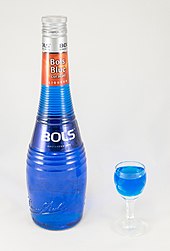Curaçao (liqueur)
 A bottle of blue curaçao | |
| Type | Liqueur |
|---|---|
| Manufacturer | (various) |
| Introduced | c. 18th century |
| Alcohol by volume | 15–40% |
| Color | Colorless, but often artificially colored with the most popular being blue and orange |
| Flavor | Bitter and sweet orange |
Curaçao
Curaçao can be sold in numerous forms, though the most common are the orange-hued dry curaçao and blue curaçao, which is dyed bright blue.
History
It is not known who developed the first curaçao liqueur, and when. The
Curaçao liqueur is traditionally made with the dried peels of the
The Bols company says that Lucas Bols (1652–1719) developed a laraha-based liqueur after the discovery that an aromatic oil could be extracted from the unripe peel of the otherwise useless bitter oranges. Bols then had this oil exported back to Amsterdam to produce a liqueur similar to current day curaçao. Lucas Bols tended to add an "element of alchemical mystery" to his products,[citation needed] explaining the unlikely addition of a blue coloring. In 1912, Bols sold blue curaçao as Crème de Ciel ("cream of the sky"), most likely a reference to the 1907 musical Miss Hook of Holland.[8][9]
Senior & Co, a company started in Curaçao, is the only company that has always produced its liqueur from the peels of the laraha from Curaçao. The family, Senior and
The liqueur is mentioned several times under the spelling "curaçoa" in William Thakeray's Vanity Fair of 1847–1848 as a drink taken by dissolute young men. For example, Lady Jane Southdown pays her brother "a furtive visit in his chambers in the Albany; and found him – O the naughty dear abandoned wretch! – smoking a cigar with a bottle of curaçoa before him."[citation needed]
Preparation

To make the liqueur, Senior and Co soak the laraha in alcohol and water for several days, after which the peel is removed and placed in a
Some other liqueurs are also sold as curaçaos with different flavors added, such as coffee, chocolate, rum and raisin. Pierre Ferrand, a cognac and dry Curaçao brand, produced a less sweet "Ancienne Méthod" curaçao using 1800s techniques.[14]
See also
- List of liqueurs
- Triple sec
References
- ^ "Definition of CURACAO".
- ^ Grimod de la Reyniere, Alexandre. Almanach des gourmands, sixième année. Paris: 1808.
- OCLC 1260690923.
- ^ "Laraha Orange – Senior Liqueur". Curacao Liqueur. Retrieved 2017-07-27.
- ISBN 0-415-27439-7.
- ^ "Curaçao Parent Stock – Elemental Mixology". Elemental Mixology. Retrieved 12 November 2017.
- ^ "Curacao". food.com. 17 August 1999.
- ^ Joseph Piercy, Slippery Tipples: A Guide to Weird and Wonderful Spirits & Liqueurs, pp. 23–24
- ^ "Bols Blue Curacao Liqueur" at Difford's Guide for Discerning Drinkers
- ^ "The Brand". Curacao Liqueur by Senior&Co. Retrieved 17 September 2023.
- ^ "Production Process - Senior Liqueur". Curacao Liqueur. Retrieved 2017-07-27.
- ^ "The Story of Blue Curaçao: Which Is, Strangely, the Other Orange Liqueur—The 9-Bottle Bar". Kitchn.
- ^ "Webpage about Curacao Liqueur and Triple secs". Archived from the original on May 29, 2013. Retrieved 2012-01-01.
- ^ Fabricant, Florence (20 March 2012). "Looking Back to the 1800s for a Properly Bitter Cocktail". The New York Times. Archived from the original on 30 May 2023.
